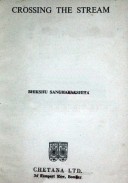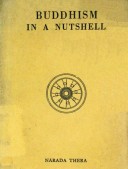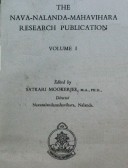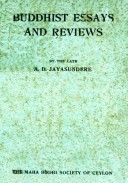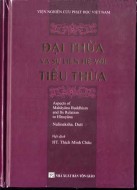Tìm Sách
Sách tiếng Anh-English >> The Path of Purification
Thông tin tra cứu
- Tên sách : The Path of Purification
- Tác giả : Bhadantàcariya Buddhaghosa
- Dịch giả : Bhikkhu Nànamoli
- Ngôn ngữ : Anh
- Số trang : 877
- Nhà xuất bản : Singapore Buddhist Meditation Centre
- Năm xuất bản : 1956
- Phân loại : Sách tiếng Anh-English
- MCB : 12010000000987
- OPAC :
- Tóm tắt :
The Path of Purification
(VISUDDHIMAGGA)
By BHADANTÀCARIYA BUDDHAGHOSA
Translated from the Pali
By BHIKKHU NÀNAMOLI
Publish by SINGAPOREBUDDHIST MEDITATION CENTRE
No.11 Neo Pee Teck Lane, Singapore 0511
Tel: 65-77833, Fax: 65-7730150
Reprinted and Donated for free distribution by
The corporate Body of the Buddha Educational Foundation
11th Flooor, 55 Hang Chow S. Rd. Sec 1. Taipei, Taiwan R.O.C
Tel: 886-2-23951198 . Fax” 886-2-23913415
FOREWORD
VISUDDHI MAGGA “ THE PATH OF PURIFICATION”
This encyclopaedic work on Theravada Buddhism “ the Path of Purification” was written by the Abrahant Bhadhantacariya Buddhaghosa some 1,580 years ago (412 AC). It is considered to be a wholsome compendium of the Buddha’s doctrine covering the strict observance of Sila or morality leading to the Purification of the body, the practise of Samadhi or concentration leading to the Purity of the mind and the development of Panna or wisdom leading to perfect Wisdom.
It is my sencere wish to arrange for the reprinting of this book so that the information could be extended and made available to those who wish to further pursue the path. It is an important part of a Buddhish’s life to “purity the mind” besides” doing good and avoiding evil”as taught by the BUDDHA.
MAY THE BLESSING OF THE TRIPLE GEM BE WITH YOU ALWAYS.
VEN. W. SARADA MAHA THERO
CONTENTS
FOREWORD TO THE SECOND EDITION
TRANSLATOR’S PREFACE
INTRODUCTION
BIBLIOGRAPHY
LIST OF ABBREVIATIONS USED
PART I. VIRTUE
I. Purification of Virtue
CHAPTER I
DESCRIPTION OF VIRTUE
I. Introduction
II. Virtue
(i) What is virtue
(ii) In what sense is it virtue?
(iii) What are its characteristic, etc.?
(iv) What are the benefits of virtue?
(v) How many kinds of virtue are there?
1. monad..
2. -8 Dyads..
9 -13 triads
14 -17 Tetrads
Virtue of the fourfold purification
18-19 . Pentads
(vi) what is the defiling of it?
(vi) what is the cleasing of it?
CHAPTER II
DESCRIPTION OF THE ASCETIC PRACTICES
PART II. CONCENTRATION
2. Purification of consciousness
CHAPTER III
DESCRIPTION OF CONCENTRATION – TAKING
A. MEDITATION SUBJECT
Concentration
(i) What is concentration?
(ii) In what sense is it concentration
(iii) What are its characteristic, etc. ?
(iv) How many kinds of concentration are there?
(v), (vi) what are the defiling and the cleansing of it?
(vii) how is it developed? (note : this heading applies as far as Ch. XI, &110)
- Development in brief
- Development in detail (see note above)
The 10 impediments
The good friend
Meditation subjects, etc.
Temperaments
Definition of meditation subjects
Self – dedication
Ways of expounding
CHAPTER IV
DESCRIPTION OF CONCENTRATION – THE EARTH KASINA
The 18 faults of a monastery
The 5 factors of the resting-place
The lesser impediments
Detailed instructions for development
The earth Kasina
The two kinds of concentration
Guarding the sign
The 10 kinds of skill in absorption
Balancing the effort
Apperance of absorption in the cognitive series
The 1st Jhana
Extending the sign
Mastery in five ways
The 2nd Jhana
The 3rd Jhana
The 4th Jhana
The fivefold reckoning of Jhana
CHAPTER V
DESCRIPTION OF CONCENTRATION – THE REMAINING KASINAS
CHAPTER VI
DESCRIPTION OF CONCENTRATION – FOULNESS AS A MEDITATION SUBJECT
CHAPTER VII
DESCRIPTION OF CONCENTRATION – SIX RECOLLECTIONS
(1). The recollection of Buddha
Dependent original
The world
(2). The recollection of the Dhamma
(3). The recollection of the Sangha
(4). The recollection of virtue.
(5). The recollection of generosity
(6). The recollection of deities
General
CHAPTER VIII
DESCRIPTION OF CONCENTRATION – OTHER RECOLLECTIONS AS MEDITATION SUBJECTS
(7). Mindfulness of death
(8). Mindfulness occupied with the body
(9). Mindfulness of breathing
(10). The Recollection of peace
CHAPTER IX
DESCRIPTION OF CONCENTRATION – THE ABIDINGS
CHAPTER X
DESCRIPTION OF CONCENTRATION – THE IMMATERIAL STATES
CHAPTER XI
DESCRIPTION OF CONCENTRATION – CONCLUSION
Perception of repulsiveness in nutriments
Definition of the 4 elements
Development of concentration – conclusion
(vii) What are the benefits of concentration ? (see Ch. III)
The benefits of concentration
CHAPTER XII
DESCRIPTION OF DIRECT – KNOWLEDGE – THE SUPERNORMAL POWERS
The benefits of concentration
(1). the kinds of supernormal power
(i) Supernormal power as resolve
(ii) Supernormal power as transformation
(iii) Supernormal power as the mind-made body
CHAPTER XIII
DESCRIPTION OF DIRECT KNOWLEDGE – CONCLUSION
(2). The divine ear element
(3). Penetration of minds
(4). Recollection of past life
World contraction by fire, etc, and expansion
(5). The divine eye – knowledge of passing away and reappearance of beings
General
PART III. UNDERSTANDING
The soil in which understanding grows
CHAPTER XIV
THE SOIL IN WHICH UNDERSTANDING GROWS – DESCRIPTION OF THE AGGREGATES
A. understanding
(i) What is understanding?
(ii) In what sense is it understanding?
(iii) What are its characteristic, etc?
(iv) How many kinds of understanding are there?
(v) How is it developd? (ends with end of Ch. XXII)
B. Description of the 5 aggregates
The materiality aggregate
The consciousness aggregate
The feeling aggregate
The perception aggregate
The formations aggregate
C. Classification of aggregates under 11 headings
D. Classes of knowledge of aggregates
CHAPTER XV
THE SOIL IN WHICH UNDERSTANDING GROWS – DESCRIPTION OF THE BASES AND ELEMENTS
The 12 bases (for contact)
The 18 elements
CHAPTER XVI
THE SOIL IN WHICH UNDERSTANDING GROWS – DESCRIPTION OF THE FACULTIES AND TRUTHS
The 22 faculties
The 4 noble truths
The noble truth of suffering
The noble truth of the origin of suffering
The noble truth of the cessation of suffering
Discussion of nibbana
The noble truth of the way leading to the cessation of suffering
General
CHAPTER XVII
THE SOIL IN WHICH UNDERSTANDING GROWS – CONCLUSION
A. Dependent origination –definiton of terms
B. Dependent origination – exposition
I. Preamble
II. Bried exposition
III. Detailed exposition
(1) Ignorance
(2) Formations
The 24 conditions
How ignorance is a condition for formations
No single fruit from single cause
(3) Consciousness
The 32 kinds of kamma-resultant consciousness
(a) in the course of an existence
(b) at the rebirth-linking
how kamma is a condition for consciousness
(4) Mentality-materiality
(5) The sixfold base
(6) Contact
(7) Feeling
(8) Craving
(9) Clinging
(10) Becoming (being)
(11), (12) Birth, etc.
C. The wheel of becoming
i.The wheel
ii. the three times
iii. Cause and fruit
iv. Various
3. Purification of view
CHAPTER XVIII
I. Introductory
II. Defining of mentality-materiality
1.Definition of mentality –materiality
i. Based on the four primsries
(a) Starting with mentality
(b) Starting with materiality
ii. Based on the 18 elements
iii. Based on the 12 bases
iv. Based on the 5 aggregates
v. Based on the 4primaries (in brief)
2.if the immaterial (mentality) fails to be discerned
3.Three ways in which the immaterial states become evident
4.there is no living-being apart from mentality-materiality
5.Interdependence of mentality and materiality
Conclusion
4. Purification by overcoming doubt
CHAPTER XIX
I. Introduction
II. Ways of discerning cause and condition
1. mentality-materiality is neither causeless nor created by a Maker
2. its occurrence is always due to conditions
3. general and particular conditions
4. Dependent cessation
5. Dependent origination
6. kamma and kamma-result
conclusion
5. Purification by knowledge and vision of what is and
What is not Path
CHAPTER XX
I. Introduction
The fifth purification
The 3 kinds of full-understanding
II. Insight
1.Method of comprehension by groups
2.strengthening of comprehension in 40 ways
3.Sharpening the faculties in 9 ways
4.Comprehension of the material
(a) As Kamma-born
(b) As consciousness-originated
(c) As nutriment-originated
(d) As temperature-originated
5Comprehension of the material
6.the material septad
7.The immaterial septad
8.The 18 principal insights
9.knowledge of rise and fall (I)
the 19 imperfections of insight
Conclusion
6 Purification by knowledge and vision of the way
CHAPTER XXI
I. Introductory
II. Insight continued – the 8 knowledge and conformity as 9th’
(1) Knowledge of contemplation of rise and fall (II)
(2) “ “ “ “ of dissolution
(3) “ “ of appearance as terror (fearful)
(4) “ “ of contemplation of danger
(5) “ “ of contemplation of dispassion
(6) “ “ of desire for deliverance
(7) “ “ of contemplation of reflexion
Discerning formations as void
(8) Knowledge of equanimity about formations
The 3 kinds of liberation
The 7 kinds of noble person
The last 3 kinds of knowledge are one
Insight leading to emergence
The 12 similes
Determination of difference in the noble path’s attributes
(9) conformity knowledge
7 Purification by knowledge and vision
CHAPTER XXII
I. Change-of-lineage knowledge, the 4 kinds of path and fuition knowledge
II. Various
1.the 37 states partaking of enghlitenment
2.emergence and coupling of the powers
3.State to be abandoned
4.Four functions in a single moment
5.Four functions separately
(a) The 3 kinds of full-understanding
(b) The 3 kinds of abandoning
i. By suppression
ii. By substitution of opposites
The 18 principal insight
iii. by cutting off
(c) the 3 kinds of realizing
(d) the 2 kinds of developing
conclusion
The venefits of understanding
CHAPTER XXIII
Introductory
(v) WHAT ARE THE BENEFITS OF DEVELOPING UNDERSTANDING
A. Removal of the various defilements
B. Fruition attainment
C. Cessation attainment
D. Accomplishment of worthiness to receive gifts
CONCLUSION (EPILOGUE)
Index of subjects and proper names
Pali-English glossary of some subjects and technical terms
Table I. The materiality aggregate
Table II. The formation aggregate
Table III. Consciousness aggregate
Table IV. The combination of the formation aggregate and consciouse aggregate
Table V. the cognition series in the occurrence of consciousness as presented in the Visuddhi-Maggha and commmentaries
Table VI. Dependent origination
 Facebook
Facebook
 Google
Google
 Google+
Google+


